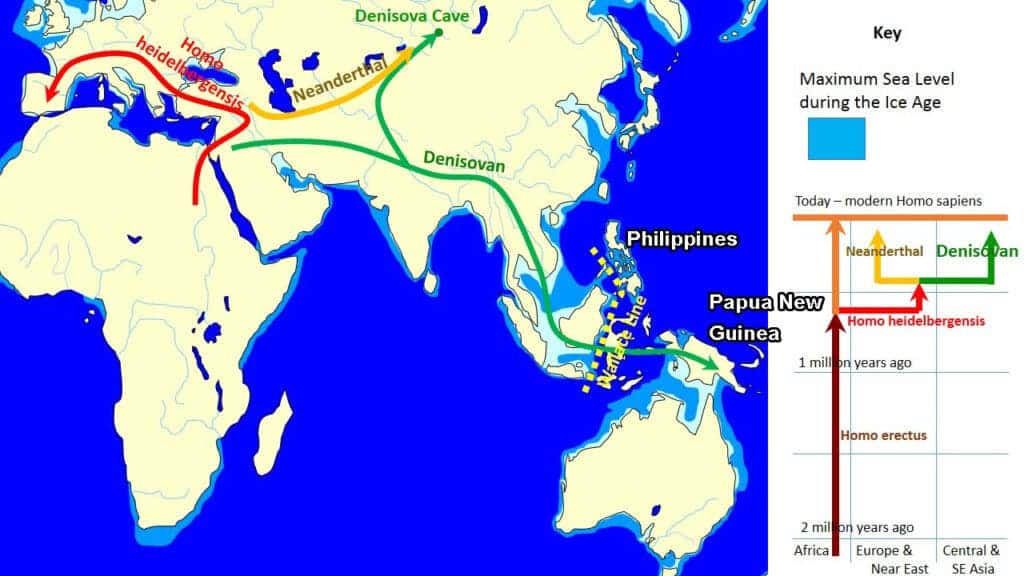Genetic analysis has found clear traces that humans and Denisovans, an ancient group of hominins, interbred in the past. In some parts of the world, Denisovan DNA is very low or undetectable, but in some parts of southeast Asia, Denisovan DNA could make up 4-6%, or maybe even more of the genetic heritage.
But what populations have the most Denisovan DNA? In other words, what people are the most Denisovan in the world? According to a new study, that would be the Philippine ethnic group known as the Ayta Magbukon.

Denisovan DNA
Very little is known about the Denisovans’ physical appearance or culture of the Denisovans, and much of what we know about them comes from genetic studies, not direct evidence. This genetic evidence suggests that they were closely related to Neanderthals, but they were different from both humans and Neanderthals. It is thought that they lived in Asia and possibly interbred with modern humans and Neanderthals, as small amounts of Denisovan DNA can be found in some modern human populations, particularly in Asia. So to study Denisovans, researchers are looking at modern groups of people that still contain their DNA.
The Negritos group in the Philippines comprises some 25 different ethnic groups, scattered throughout the Andaman archipelago in South-East Asia. They were once considered to be a single population, but the more researchers looked into it, the more they found that Negritos are actually very diverse.
In the new study, Maximilian Larena of Uppsala University and colleagues set out to establish the demographic history of the Philippines. Their project involved indigenous cultural communities, local universities, as well as official and non-governmental organizations from the area. With everyone working together, they were able to analyze 2.3 million genotypes from 118 ethnic groups in the Philippines — including the diverse Negrito populations.
The results were particularly intriguing for a population called the Ayta Magbukon, which still occupy vast swaths of their ancestral land and continue to coexist with the lowland population surrounding them. The Ayta Magbukon seem to possess the highest level of Denisovan ancestry in the world.
“We made this observation despite the fact that Philippine Negritos were recently admixed with East Asian-related groups—who carry little Denisovan ancestry, and which consequently diluted their levels of Denisovan ancestry,” said Larena “If we account for and masked away the East Asian-related ancestry in Philippine Negritos, their Denisovan ancestry can be up to 46 percent greater than that of Australians and Papuans.”
This finding, along with the recent discovery of a small-bodied hominin called Homo luzonensis, suggests that multiple hominin species inhabited the Philippines prior to the arrival of modern humans — and these groups likely interbred multiple times.
Denisovan origins
All Eurasians possess some level of Neanderthal DNA, whereas Australasians uniquely have relatively elevated levels of Denisovan ancestry.
The Denisovans are a mysterious group of hominins identified in 2010 based on mitochondrial DNA (mtDNA) extracted from a juvenile female finger bone from the Siberian Denisova Cave. Although researchers haven’t found numerous traces of DNA, they’ve discovered traces of their DNA in modern populations. Apparently, this group in the Philippines has the highest percentage of Denisovan DNA in the world — at least that we’ve found so far.
“This admixture led to variable levels of Denisovan ancestry in the genomes of Philippine Negritos and Papuans,” co-author Mattias Jakobsson said. “In Island Southeast Asia, Philippine Negritos later admixed with East Asian migrants who possess little Denisovan ancestry, which subsequently diluted their archaic ancestry. Some groups, though, such as the Ayta Magbukon, minimally admixed with the more recent incoming migrants. For this reason, the Ayta Magbukon retained most of their inherited archaic tracts and were left with the highest level of Denisovan ancestry in the world.”
Researchers hope to sequence more genomes and better understand “how the inherited archaic tracts influenced our biology and how it contributed to our adaptation as a species,” Larena concludes.
Journal Reference: “Philippine Ayta possess the highest level of Denisovan ancestry in the world”


